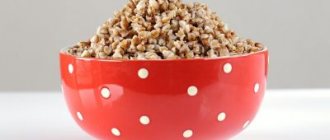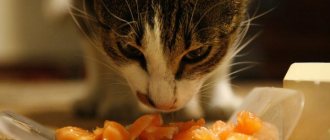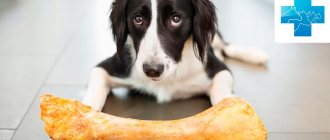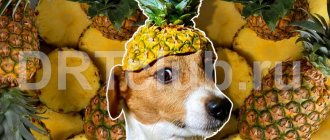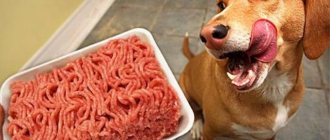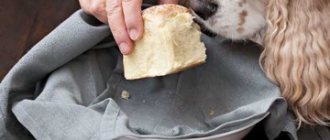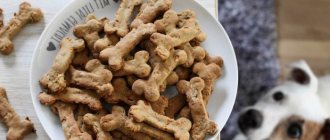Most dog breeders, being adherents of natural feeding for their four-legged pets, fundamentally refuse dry food. Sometimes, for example, in the case of a dog’s illness, experts consider it advisable to switch it to “natural” food.
In this regard, questions about what to feed a dog, which foods must be included in the diet, and which ones should be avoided, become relevant for pet owners. Porridge is one of the most popular dishes, but this does not mean that any cereal can be given to animals.
Buckwheat porridge
According to experts, buckwheat is for animals. It contains vitamins (A, B, E, H, PP), minerals (iron, calcium, zinc, magnesium, etc.), fiber, complex carbohydrates, amino acids.
Buckwheat saturates the body, fills it with vigor and energy.
The value of buckwheat lies in accelerating metabolism, stabilizing the cardiovascular system, strengthening the immune system and bone tissue. Thanks to its unique composition, buckwheat allows the body to rehabilitate faster in the postoperative period. Thanks to it, the dog does not gain weight, and also forgets about what allergies are.
Buckwheat porridge is considered the best option for a pet, but it must be prepared correctly. Here is the method recommended by veterinarians: pour 1 cup of buckwheat into 2 cups of boiling water. Cover the pan with a lid and wrap it in a blanket. Leave overnight. The next morning the porridge is ready to eat. Since most of the beneficial substances are lost during heat treatment, there is no need to cook the dish, nor do you need to add salt and pepper.
Rules for using pearl barley
It is best to alternate pearl barley with other, more digestible cereals - for example, buckwheat, oatmeal or rice. Eating pearl barley porridge once or twice a week will be quite enough. Optimally, in the daily diet one should make up 1/3 of the total amount of food, preferably mixed with vegetables or meat.
Important: even if a dog eats pearl barley with pleasure, you need to clearly monitor the serving size, calculating it based on the weight of the animal.
For better digestibility, it is recommended to cook the cereal in beef broth.
Recipe:
- Prepare beef bone broth. Strain the liquid so that there are no small seeds or spices left in it.
- Rinse the pearl barley and fill it with broth, covering the level of the cereal by two fingers.
- After boiling, reduce the heat, cover the container with a lid, add a little salt and cook until fully cooked. Average cooking time is 2 hours. Add boiled water as needed.
- 5-10 minutes before readiness, add already cooked vegetables and meat to the pan so that they warm up and mix with the porridge.
Important: in order for the porridge to cook faster, it must first be soaked in water. Proportions: 1 cup of cereal per 1 liter of cold water. It is advisable to leave the “solution” overnight or for 5-6 hours. Well-swollen and softened pearl barley will cook for an average of 30 minutes.
Rice porridge
Rice is enriched with vitamins B, E, magnesium, calcium, zinc, iron, copper and other minerals, lipids. Cereals are a natural antioxidant and adsorbent and cleanse the body of toxins. That is why it is recommended for dogs that have previously been diagnosed with poisoning. In addition, it is endowed with astringent properties, so it is useful for animals with diarrhea.
Rice porridge gently envelops the stomach and reduces pain, so pets suffering from inflammatory processes in the digestive tract should definitely eat this dish.
However, rice also has contraindications. Due to its high starch content, it can be harmful to dogs with diabetes, obesity, and diarrhea. This does not mean that rice porridge is prohibited for such patients, it just needs to be given occasionally, to diversify the diet.
Preference should be given to unpolished rice, since it contains less starch than polished rice and more vegetable protein.
Method of preparation: rinse the cereal, soak it for an hour and a half in cold water. Soaking unpolished rice - 20 minutes. Boil. If the porridge turns out to be thick, you can add a little vegetable oil.
Pregnant or breastfeeding
Pearl barley does not play a significant role in the diet of pregnant bitches. You can give it, but a little at a time, given that the dog during this period needs food high in protein, since it is the main building material.
This cereal promotes weight gain, and overly fat animals have a difficult birth, so it is better to reduce the amount of cereal products during this period.
A nursing dog can eat pearl barley in the same quantities as before pregnancy.
Oats
Oats and rolled oats should not be confused. Oats are whole grains, while rolled oats are flattened grains. However, both cereals are very useful for your pet. They contain vitamins A, B, E, PP, minerals (calcium, potassium, magnesium, sodium, etc.), vegetable proteins, amino acids, fats.
Diet porridge is an indispensable product for normalizing digestion after an illness accompanied by vomiting and diarrhea, or prolonged fasting. Gluten delicately envelops the intestines and walls of the digestive tract, and has a beneficial effect on the stomach and pancreas during inflammation. Oatmeal and jelly are always recommended by nutritionists for animals with gastritis and enteritis.
Do not forget: oatmeal can cause allergies and digestive upset. If you are giving oatmeal for the first time, add it in small quantities to the main dish to check whether it will become an allergen for your pet, and observe for a day. If your dog does not have an allergic reaction to oatmeal, include it in the diet, but do not overuse it.
It is advisable to give preference to oats other than oatmeal. It takes longer to cook, but it contains more nutrients. To prepare the grains, soak them in cold water for 2-3 hours, then boil them without adding salt. With soaking, the cereal will cook in 40-50 minutes.
What cereals can be given to dogs of small and large breeds
For some reason, people very often believe that the choice of cereals is different for large and small breeds. This is wrong. Buckwheat and oats (rolled oats) are best suited for the diet of both large and small dogs. But it is better to avoid corn, semolina and some other cereals. We have already written about all this in the relevant sections of the article.
From the author. We feed our Irish Setter exclusively natural food. For breakfast we give cottage cheese and kefir. And for dinner, porridge and meat, usually rolled oats, less often buckwheat.
Semolina
Semolina, like millet, is an absolutely useless product for dogs. Semolina contains no useful substances, but a lot of simple carbohydrates.
However, the doctor may recommend it to premature newborn puppies to gain weight or to animals with gastrointestinal inflammation (for the period of treatment, so as not to burden the stomach and intestines).
Semolina is contraindicated for dogs that are overweight, prone to obesity, sedentary individuals and animals with diabetes (cereals contribute to an increase in blood sugar levels).
How and with what to give?
Barley should be included in the diet occasionally, alternating with other, more easily digestible cereals: rice, buckwheat and oatmeal. The best option is 1, maximum 2 times a week.
Barley should make up no more than 1/3 of the daily diet, mixed with meat and boiled vegetables. For better digestibility, it is cooked in beef broth.
If a dog loves pearl barley, then it will be willing to eat it, and it is important to calculate the serving size based on the weight of the animal in order to prevent overfeeding.
Barley porridge
Despite the fact that this cereal is very nutritious and enriched with vitamins, micro- and macroelements (fluorine, silicon), it is not suitable for daily use. The fact is that it is poorly absorbed by the body. Nevertheless, it must be given. For it to really bring benefits, it is better to mix it with other porridges, for example, with buckwheat.
Tip: feed your pet only freshly cooked porridge, after cooling it to room temperature. A cold dish turns into an unappetizing mess and is not absorbed by the body.
Why can't you feed it?
The dog's body sometimes cannot digest porridge. The main reason why pearl barley is harmful is its inability to be quickly absorbed. This is dangerous for representatives of breeds characterized by an inactive lifestyle, accustomed to lying down and sleeping after eating.
In other cases, the cereal will simply exit the body in its original form - undigested large grains. Barley is useful for dogs only when they are able to completely digest it.
Cereals can occasionally be present in the diet, then the animal will receive the maximum possible value of the product.
You should not give pearl barley to small toy dogs. Their internal organs, including the digestive system, are small in size. Barley, leaving the body as grains, can cause constipation, problems with stool, and disruptions in the digestive system. When deciding whether or not to feed your pet barley, you need to take into account the dog’s weight. The high calorie content of cereals can cause obesity and related diseases.
Corn porridge
Regarding whether it is possible to give a dog corn porridge, veterinarians agree: no, it is not! Just like millet and semolina, corn is completely useless for animals. Undoubtedly, it quenches the appetite well and gives a feeling of satiety, but it does not provide any nutritional value. But it's not only that.
Porridge passes through the gastrointestinal tract very difficultly, forms clumps and is poorly digested. In dogs that lead an active lifestyle, it can cause volvulus, a dangerous pathology. Under no circumstances should you give corn porridge to animals experiencing digestive problems, otherwise exacerbations cannot be avoided.
It is much more useful to offer the dog to chew on a fresh corn cob, but you need to make sure that he does not get carried away and get to the core. Don't be alarmed if the grains come out undigested in your feces.
Possible reactions
Since pearl barley is difficult for the body to digest, not all dogs are able to digest it quickly and correctly. In this regard, problems with intestinal function may arise:
- Diarrhea. The stomach of some breeds of dogs is unable to process pearl barley porridge, as a result of which the dog will defecate whole grains - exactly the same as they got inside. This often happens right next to the food bowl in an uncontrolled manner.
- Allergy. Signs: scabies, the appearance of pink and pink-red spots on the skin, tearing, hair loss. In rare cases, even otitis media and other seemingly unrelated diseases may appear.
- Constipation. The opposite reaction, especially if you feed the animal pearl barley often and in large quantities. The most susceptible to constipation are large breeds of dogs, whose bodies are naturally prone to volvulus.
- Partial or complete refusal to eat. Porridge that is not processed in the stomach creates a feeling of false satiety. The result is a lack of appetite. If your dog is regularly fed pearl barley, obesity may develop, especially in older animals or those leading a sedentary lifestyle.
What to add to porridge
As mentioned above, salt and spices should not be added to porridge. And excess fats will not be beneficial for your pet. However, you won’t be satisfied with porridge alone, so add meat and vegetables to it.
Vegetables are rich in fiber, which is beneficial for intestinal motility. Carrots, beets, rutabaga, pumpkin, and zucchini are most suitable for this purpose. You can give broccoli, cauliflower, and potatoes with caution. But you can’t give onions and garlic.
As for meat, the ideal option is turkey and rabbit, veal, horse meat. These are lean meats that will not harm the liver and are hypoallergenic.
Pork and lamb are too fatty, so they should be excluded from the menu.
Chicken is a dietary product, but it can cause allergies. Meat products must be subjected to heat treatment; frozen meat is also allowed.
By-products are very useful. The liver is a source of vitamins and micro- and macroelements; the heart, rumen, and lungs are good in this regard. They should be included in the diet boiled, as offal can be contaminated with helminths.
Cereals for different dogs
In addition to knowledge of the properties of cereals and methods of their preparation, you should especially carefully select the diet according to the age and health of the animal. For example, something that will benefit a puppy may be dangerous for an adult dog.
So, when choosing products for dogs, all aspects are taken into account, including weight, age and even breed, because there are individual characteristics of artificially bred forms. For example, the Basset Hound is a vegetable dog and its diet should contain a range of fresh foods. Many varieties have such features; they need to be known and taken into account when creating a diet.
Puppies
Small dogs need special attention and nutrition; their children's bodies still digest lactose, so porridge is cooked in milk. Semolina is the best way to gain weight, so it would be appropriate here. It is given from a month onwards to babies with developmental delays.
It is important not to overdo it; as soon as the dog begins to gain weight, it is switched to a less calorie diet.
It is recommended to gradually introduce cereals into the diet, in particular buckwheat and rice, and add the rest little by little over time. It is advisable to eliminate dairy products by 6 months. Porridge should be cooked in meat broth with the addition of vegetables and small pieces of meat. A one-year-old dog is switched to adult food.
Adults
Dogs that are a year old or more eat everything. Their diet should be varied and balanced. Carbohydrates and proteins are combined in a ratio of 3:7. Dairy products are completely excluded and begin to reappear in the dog’s life in old age.
Carbohydrates are strictly prohibited for elderly animals, so cereals are removed and replaced with cottage cheese and vegetables. Fermented milk products help strengthen bones, and vegetables improve digestion and saturate the body with vitamins.
Pregnant and lactating females
During pregnancy and feeding of offspring, vitamins and minerals in the dog’s body are not restored, so buckwheat and rice are cooked in milk. Mix a few tablespoons of oatmeal into the cereal. It is also good to feed the bitch with cottage cheese and kefir, and diversify the food with vegetables.
The best meats are rabbit and beef.

